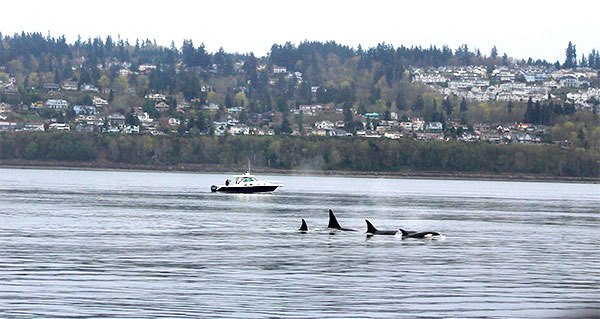Curiosity and excitement abounded on board the Mystic Sea whale charter boat recently as passengers rushed to the railing and windows to spy their first whales of the day, a group of five transient orcas making their way past the Mukilteo Ferry Dock.
For some, like passengers Kevin and Janet Craig, it was their first sighting of a whale in the wild.
The couple had just moved to Oak Harbor from Indiana about six months ago.
“We’re still like tourists,” Janet Craig said, laughing.
The couple said they had little prior knowledge about marine species, but enjoyed seeing them in their natural habitat.
“I really enjoyed it, it was neat,” Janet Craig said.
The sighting came within about half an hour of the boat’s 11 a.m. departure from the South Whidbey Harbor at Langley March 22, and was followed by a handful of additional sightings throughout the next three hours at sea.
The Mystic Sea departs from the South Whidbey Harbor at Langley for sightings of gray whales from March 7 through May 10. Orca season runs from May 15 through October 4, though some lucky groups such as those aboard the March 22 cruise will have the opportunity to see both species in a single outing.
“We don’t get much better than orcas and grays in one day,” said Mystic Sea Captain Monte Hughes.
Jill Hein, a member of Beach Watchers’ and Orca Network’s board of directors, serves as the volunteer naturalist aboard Mystic Sea Charters once a week. Hein makes her rounds giving educational talks and answering questions from curious passengers.
Though members of the resident orca pod have been spotted in the waters of Puget Sound year-round, gray whales and members of the transient orca population have begun to make their journey north from California through the Salish Sea to Alaska.
The grays will depart for Alaska some time between May and early June. In the fall, more orcas are expected to arrive in the waters around Whidbey. There will also be plenty of opportunity for sightings of humpbacks, orcas and minke whales during the summer, particularly further north near the San Juans.
For Whidbey Islanders like Orca Network co-director and co-founder Howard Garrett and fellow marine mammal enthusiasts, it is quite an exciting time of year.
Garrett explained that about 10-12 grays, the more “mysterious” of the two species, are expected to be coming through Puget Sound this year.
Garrett noted that these whales are more elusive in their behavior, and the nature of their relationships with one another are relatively unknown.
Hein explained that the grays are “stopping in for a snack,” and had been feasting on shrimp in the mudflats near Everett.
By the time they reach the Sound, she said, they haven’t eaten for four to five months.
“The gray whales know the buffet table is full of their favorite shrimp lining the shores,” Garrett said.
Orcas, which Garrett described as more charismatic and popular, have well-documented social patterns.
Family bonds remain for life; babies stay with their mothers and grandmothers, and pods work together. The whales also transmit their cultures which determine their diets and mating practices, according to Garrett.
“We know a whole lot about them, their ages and relationships, so that gives us much more to appreciate about them,” Garrett said, adding that the orca’s ability for all-encompassing cultural transmissions from one generation to another is “quite fascinating and unprecedented in wildlife biology.”
The Southern Resident population eats almost exclusively Chinook salmon, and has been placed on the endangered species list. The eldest member of the pod, “Granny J-7” is estimated to be about 104 years old.
Whale charter boat operators like Hughes decide the direction of their daily whale-seeking course based upon information from numerous sources, including on-shore whale-watchers, Orca Network and marine traffic radio communications.
Hughes noted that he and his passengers have spied at least one or two whales on each of his cruises thus far this year.
The March 22 excursion was unusually fruitful, with five orcas and three gray whales spotted.
Aside from the transient pod near Mukilteo, Patch and no. 22, two gray whales, were seen near Glendale; a third unidentified gray was also spotted off of the Clinton Ferry Dock; and a fourth was just off Hat Island. In addition, passengers got a glimpse of a California sea lion and numerous birds.
Hughes asked the group of 58 passengers to assist in spotting the whales, a task everyone seemed happy to oblige.
“When you yell ‘Whale!’ everyone goes to one side of the boat,” Hughes said with a chuckle.



